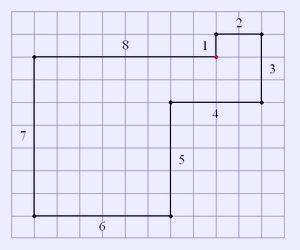.
Golygon
A golygon (technically referred to as a 'serial isogon of 90 degrees') is any polygon with all right angles, whose sides are consecutive integer lengths. Golygons were invented and named by Lee Sallows, and popularized by A. K. Dewdney in a 1990 Scientific American column (Smith). Variations on the definition of golygons involve allowing edges to cross, using sequences of edge lengths other than the consecutive integers, and considering turn angles other than 90°.

An example of a simple 8-sided golygon
In any golygon, all horizontal edges have the same parity as each other, as do all vertical edges. Therefore, the number n of sides must allow the solution of the system of equations
![]()
![]()
It follows from this that n must be a multiple of 8.
The number of solutions to this system of equations may be computed efficiently using generating functions (sequence A007219 in OEIS) but finding the number of solutions that correspond to non-crossing golygons seems to be significantly more difficult.
There is a unique eight-sided golygon (shown in the figure); it can tile the plane by 180-degree rotation using the Conway criterion.
References
* Dewdney, A. K. (1990). "An odd journey along even roads leads to home in Golygon City". Scientific American 263: 118–121.
* Sallows, Lee (1992). "New pathways in serial isogons". The Mathematical Intelligencer 14: 55–67.
* Sallows, Lee; Gardner, Martin; Guy, Richard K.; Knuth, Donald (1991). "Serial isogons of 90 degrees". Mathematics Magazine 64 (5): 315–324.
* Harry J. Smith. What is a Golygon?.
* Eric W. Weisstein, Golygon at MathWorld.
Links
* Golygons at the On-Line Encyclopedia of Integer Sequences
Undergraduate Texts in Mathematics
Graduate Studies in Mathematics
Retrieved from "http://en.wikipedia.org/"
All text is available under the terms of the GNU Free Documentation License

